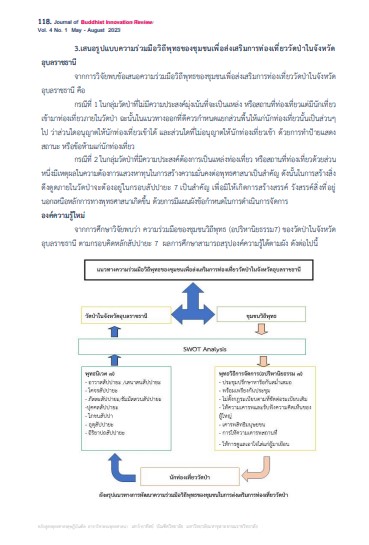Buddhist Cooperation Model of Community for Promoting Tourism at Forest Temple in UbonRatchathani Province
Main Article Content
Abstract
The objectives of this dissertation is 1) to study the Buddhist way of community cooperation for promoting forest monastery tourism, 2) To analyze a way to build the Buddhist way of community cooperation for promoting forest monastery tourism, 3) to propose the Buddhist way of community cooperation for promoting forest monastery tourism in UbonRatchathani Province. This research uses both quantitative and qualitative research methods.
1)The study found that the Buddhist principle of seven conditions for non-decline, Aparihāniya dhamma, is the tool for community cooperation administration to promote forest monastery tourism. Creating tourism attractions in accordance with the principle of seven suitable things, sappāya, is also consistent with the concept of 5A theory. According to the tourist behavior data, the significant potential of the forest monasteries is nice weather, and good environment (utu sappāya), and accommodation (āvāsa sappāya) which has the highest mean ( = 3.68, S.D.=0.40). The aspect that should be further improved and developed is the traveling route (gojara sappāya) which has the least mean in the assessment ( = 3.65, S.D.=0.37).
2)The research found that the Buddhist way for community cooperation to promote forest monastery tourism in Ubon Ratchathani is at a moderate level ( = 3.20, S.D. = 0.05). For each aspect, cooperative meeting with the forest monastery has the highest mean ( = 3.48, S.D.= 0.13). Mutual respect for one other comes last ( = 2.77, S.D.=0.07). When analyzing both data using the SWOT analysis technique, we can well formulate a policy to improve the weak point of each monastery.
3)Therefore, for proposing the Buddhist way of community cooperation to promote forest monastery tourism in Ubon Ratchathani, the Buddhist community must adhere to the principle of seven conditions for non-decline, Aparihāniya dhamma. This can start with community meeting to discuss and present ways to promote the forest monasteries through Buddhist ritual activities. This also relies on faith and confidence in the Buddhist monks. It is important to create the attractions in the forest monasteries according to the principle framework of seven suitable things, sappāya and not to create any other attractions outside the Buddhist principles.
Article Details

This work is licensed under a Creative Commons Attribution-NonCommercial-NoDerivatives 4.0 International License.
เรื่องลิขสิทธิ์/เป็นความคิดเห็นของผู้เขียน
References
หนังสือ
จุฑาภรณ์ หินซุย. (2551). การศึกษาเรื่องแนวทางส่งเสริมการท่องเที่ยว เชิงพุทธ กรณีศึกษาวัดประชาคมวนาราม อำเภอศรีสมเด็จ จังหวัดร้อยเอ็ด. รัฐประศาสนศาสตรมหาบัณฑิต. วิทยาลัยการปกครองท้องถิ่น. บัณทิตวิทยาลัย :มหาวิทยาลัยขอนแก่น.
ภัทร์สุภา ลีลานภาพรรณ์. (2551). การท่องเที่ยวเชิงพุทธ: กรณีศึกษาแหล่งวัฒนธรรมในกรุงเทพมหานคร. สารนิพนธ์ ปริญญาศาสนศาสตรมหาบัณฑิต สาขาพุทธศาสน์ศึกษา.บัณฑิตวิทยาลัย: มหาวิทยาลัยมหามกุฏราชวิทยาลัย.
พฤฒ เอมมานูเอล ใบระหมาน. (2552). การสร้างความร่วมมือเพื่อต่อต้านการค้าแรงงานทาสบนเรือประมง. ภาคนิพนธ์ รัฐศาสตร์มหาบัณฑิต คณะรัฐศาสตร์. บัณฑิต: มหาวิทยาลัยธรรมศาสตร์.
พระสมหมาย อตฺถสิทฺโธ (พืชสิงห์). (2559). รูปแบบการนำหลักอปริหานิยธรรมไปใช้ในการบริหารของผู้บริหารสังกัดองค์การปกครองส่วนท้องถิ่น จังหวัดร้อยเอ็ด. วิทยานิพนธ์ดุษฎีบัณฑิตบัณฑิต สาขาวิชาพระพุทธศาสนา. บัณฑิตวิทยาลัย: มหาวิทยาลัยมหาจุฬาลงกรณราชวิทยาลัย.
รายงานวิจัย:
เกษสุดา งามขวา.(2543). พระธาตุดุม:แนวทางการอนุรักษ์ สิ่งแวดล้อมศิลปกรรม เพื่อส่งเสริมการ ท่องเที่ยว. รายงานการวิจัยหน่วยอนุรักษ์สิ่งแวดล้อมศิลปกรรม. ข้อมูลหายไป
วสันต์ เทพสุริยานนท์. (2552). ชุมชนร่วมรัฐ: กระบวนการเสริมสร้างเครือข่ายมรดกศิลปวัฒนธรรมบ้านหมอสอ จังหวัดกาญจนบุรี. รายงานการวิจัยเสนอต่อการท่องเที่ยวแห่งประเทศไทย. เครือข่ายมรดกศิลปะวัฒนธรรมบ้านหมอสอ องค์การบริหารส่วนตำบลพระแท่น สำนักศิลปากรที่ 2 สุพรรณบุรี.
สื่ออิเล็กทรอนิกส์
กระทรวงการท่องเที่ยวและกีสถิติด้านการท่องเที่ยว ปี 2563 (Tourism Statistics 2020)[ออนไลน์]. (วันที่สืบค้น 29 กุมภาพันธ์ 2565). แหล่งที่มา : https://mots.go.th/more_news_new.php?cid=592.


